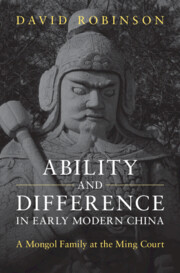Refine search
Actions for selected content:
2587 results
8 - Enter China
-
- Book:
- Hierarchy and the State
- Published online:
- 20 August 2025
- Print publication:
- 02 October 2025, pp 161-190
-
- Chapter
- Export citation
7 - Genealogies of Auto-Centered Development
- from Part II - Schools of Thought
-
-
- Book:
- Anticolonialism and Social Thought
- Published online:
- 16 September 2025
- Print publication:
- 25 September 2025, pp 162-185
-
- Chapter
- Export citation
Chinese healthy diet and cardiometabolic multimorbidity risks: a prospective cohort study from the China Health and Nutrition Survey
-
- Journal:
- British Journal of Nutrition / Accepted manuscript
- Published online by Cambridge University Press:
- 15 September 2025, pp. 1-27
-
- Article
-
- You have access
- Export citation
4 - Educating the Entitled
-
- Book:
- Ability and Difference in Early Modern China
- Published online:
- 10 September 2025
- Print publication:
- 11 September 2025, pp 82-114
-
- Chapter
- Export citation
9 - Turning Every Page
-
- Book:
- Ability and Difference in Early Modern China
- Published online:
- 10 September 2025
- Print publication:
- 11 September 2025, pp 212-230
-
- Chapter
- Export citation
3 - The Sovereign’s Man
-
- Book:
- Ability and Difference in Early Modern China
- Published online:
- 10 September 2025
- Print publication:
- 11 September 2025, pp 60-81
-
- Chapter
- Export citation
8 - Holding against the Storming
-
- Book:
- Ability and Difference in Early Modern China
- Published online:
- 10 September 2025
- Print publication:
- 11 September 2025, pp 186-211
-
- Chapter
- Export citation
7 - Patronage, Assessment, and Power
-
- Book:
- Ability and Difference in Early Modern China
- Published online:
- 10 September 2025
- Print publication:
- 11 September 2025, pp 163-185
-
- Chapter
- Export citation
Conclusion
-
- Book:
- Ability and Difference in Early Modern China
- Published online:
- 10 September 2025
- Print publication:
- 11 September 2025, pp 247-251
-
- Chapter
- Export citation
1 - An Age of Decisions
-
- Book:
- Ability and Difference in Early Modern China
- Published online:
- 10 September 2025
- Print publication:
- 11 September 2025, pp 23-40
-
- Chapter
- Export citation
10 - Seizing Fortune
-
- Book:
- Ability and Difference in Early Modern China
- Published online:
- 10 September 2025
- Print publication:
- 11 September 2025, pp 231-246
-
- Chapter
- Export citation
Introduction
-
- Book:
- Ability and Difference in Early Modern China
- Published online:
- 10 September 2025
- Print publication:
- 11 September 2025, pp 1-22
-
- Chapter
- Export citation
2 - Dying for His Lord
-
- Book:
- Ability and Difference in Early Modern China
- Published online:
- 10 September 2025
- Print publication:
- 11 September 2025, pp 41-59
-
- Chapter
- Export citation
6 - Far from Home
-
- Book:
- Ability and Difference in Early Modern China
- Published online:
- 10 September 2025
- Print publication:
- 11 September 2025, pp 138-162
-
- Chapter
- Export citation
5 - Representing the Emperor
-
- Book:
- Ability and Difference in Early Modern China
- Published online:
- 10 September 2025
- Print publication:
- 11 September 2025, pp 115-137
-
- Chapter
- Export citation

Ability and Difference in Early Modern China
- A Mongol Family at the Ming Court
-
- Published online:
- 10 September 2025
- Print publication:
- 11 September 2025
Institutional reforms and regulatory shifts in China’s digital platform sector: how domain-specific centralization shaped the 2020–2022 transition
-
- Journal:
- Business and Politics , First View
- Published online by Cambridge University Press:
- 08 September 2025, pp. 1-20
-
- Article
-
- You have access
- Open access
- HTML
- Export citation
Rangeland Governance and Practices in Amdo Tibet, China: Legal Pluralism in Pastoral Communities
-
- Journal:
- The China Quarterly , First View
- Published online by Cambridge University Press:
- 05 September 2025, pp. 1-17
-
- Article
- Export citation
International State Building and Civilian Preferences: Experimental Evidence from Liberia
-
- Journal:
- International Organization , First View
- Published online by Cambridge University Press:
- 05 September 2025, pp. 1-27
-
- Article
-
- You have access
- Open access
- HTML
- Export citation
Guerrilla Lawyering: Mobile Resistance in China’s Environmental Public Interest Litigation
-
- Journal:
- Law & Society Review ,
- Published online by Cambridge University Press:
- 04 September 2025, pp. 1-27
-
- Article
-
- You have access
- Open access
- HTML
- Export citation
